
Mira, the 10-petaflop IBM Blue Gene/Q supercomputer housed at the Argonne Leadership Computing Facility, was retired at the end of 2019. (Image: Argonne National Laboratory)
To commemorate Mira’s lasting impact on scientific computing, we take a look back at some of the notable research advances made possible by the ALCF’s 10-petaflop IBM Blue Gene/Q supercomputer.
On December 31, 2019, Mira’s long run of enabling science as a leadership-class supercomputer at the U.S. Department of Energy’s (DOE) Argonne National Laboratory came to an end.
Housed at the Argonne Leadership Computing Facility (ALCF), a DOE Office of Science User Facility, Mira delivered nearly 40 billion core-hours to more than 800 projects since its launch in 2012, accelerating breakthroughs in fields ranging from materials science to astrophysics.
To commemorate Mira’s lasting impact on scientific computing, we take a look back at some of the notable research advances made possible by our 10-petaflop IBM Blue Gene/Q supercomputer.
Improving the design of wind turbines and jet engines
Scientists from GE Global Research used Mira to study the complex behavior of air as it passes through jet exhaust nozzles and over wind turbine blades. The team performed large eddy simulations to accurately characterize some of the key flow physics of multiscale turbulent mixing phenomena, measuring variables such as velocity, temperature, and pressure. GE uses information derived from these simulations to inform the design of quieter, more efficient wind turbines and jet engines.

Noise generation due to turbulent mixing of exhaust flow. Large eddy simulation of exhaust flow from a 2-inch conic nozzle with exit Mach number of 0.97. Visualizing density gradients in the flow. (Image: Joseph Insley, Argonne National Laboratory; Umesh Paliath, GE Global Research)
Modeling supernovae at an unprecedented level of detail
A research team from Michigan State University has leveraged Mira to carry out some of the largest and most detailed 3D simulations ever performed of core-collapse supernovae. The emergence of petascale supercomputers like Mira made it possible to include high-fidelity treatments of rotation, magnetic fields, and other complex physics processes that were not feasible in previous supernova simulations. The team’s 3D simulations on Mira helped advance the study of supernovae, shedding new light on the physical mechanisms that drive these stellar explosions. Their work continues on the ALCF’s Theta supercomputer.
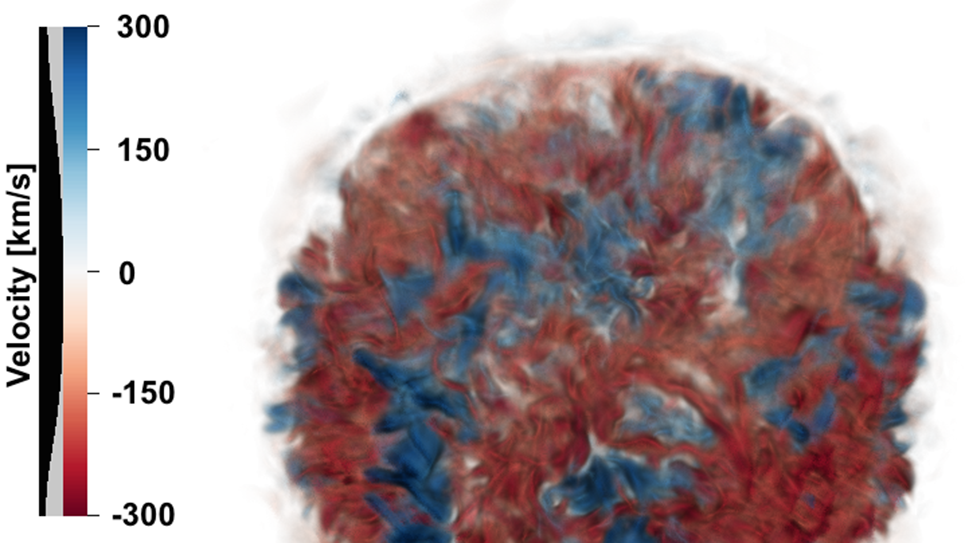
Researchers from Michigan State University used Mira to perform 3D simulations of the final moments of a core-collapse supernova’s life cycle. This visualization is a volume rendering of a massive star's radial velocity. In comparison to previous 1D simulations, none of the structure seen here would be present. (Image: Sean M. Couch, Michigan State University)
Developing new materials to combat friction
A multidisciplinary team from Argonne used Mira to identify and improve a new mechanism for eliminating friction. Their simulations led to the synthesis of a novel material that demonstrated superlubricity (near zero friction) at the macroscale for the first time. Limited to dry environments, potential applications for the material include wind turbine gears and magnetic disc drives in computers. In a follow-up study using the Mira simulations, the researchers also developed a self-generating dry lubricant that can re-adjust itself continuously, enabling it to last longer than traditional dry lubricant materials. The team’s research, which demonstrates how computation can advance the design and discovery of new materials, has resulted in multiple patents for the friction-reducing materials.
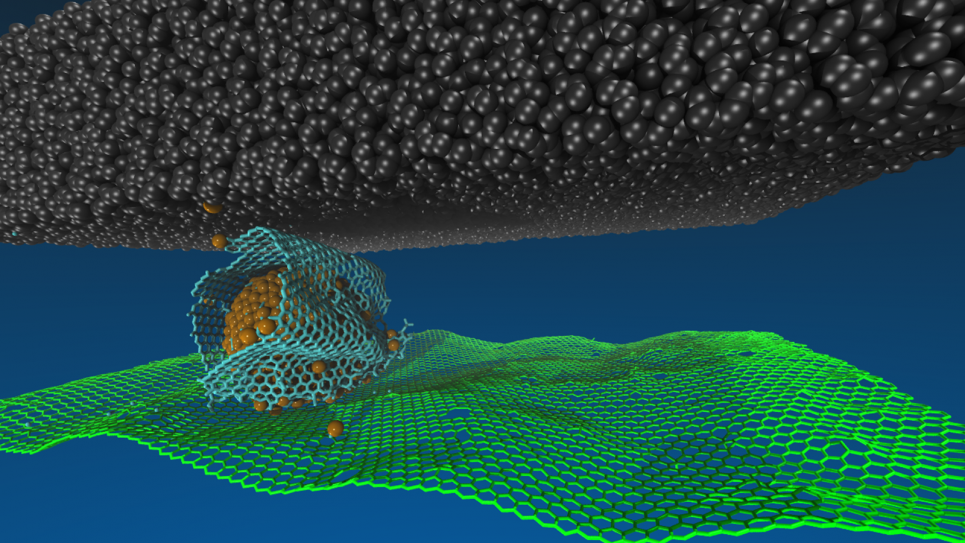
This large-scale simulation depicts a phenomenon called superlubricity, a property in which friction drops to near zero. The simulation reveals that this condition originates at the nanoscale when graphene atoms self-assemble into nanoscrolls that reduce contact area to help eliminate friction. (Image: Sanket Deshmukh, Joseph Insley, and Subramanian Sankaranarayanan, Argonne National Laboratory)
Advancing microscopy technique for early cancer detection
Researchers from Northwestern University tapped Mira to advance the development of an optical microscopy technique that can predict and quantify cancer risks at extremely early stages. The team’s technique, known as Partial Wave Spectroscopic (PWS) microscopy, is capable of detecting static intracellular nano-architectural alterations that are not accessible using conventional optical microscopy. Leveraging Mira, they performed simulations to inform the development of a new dynamic PWS technique that can detect macromolecular motions in living cells.
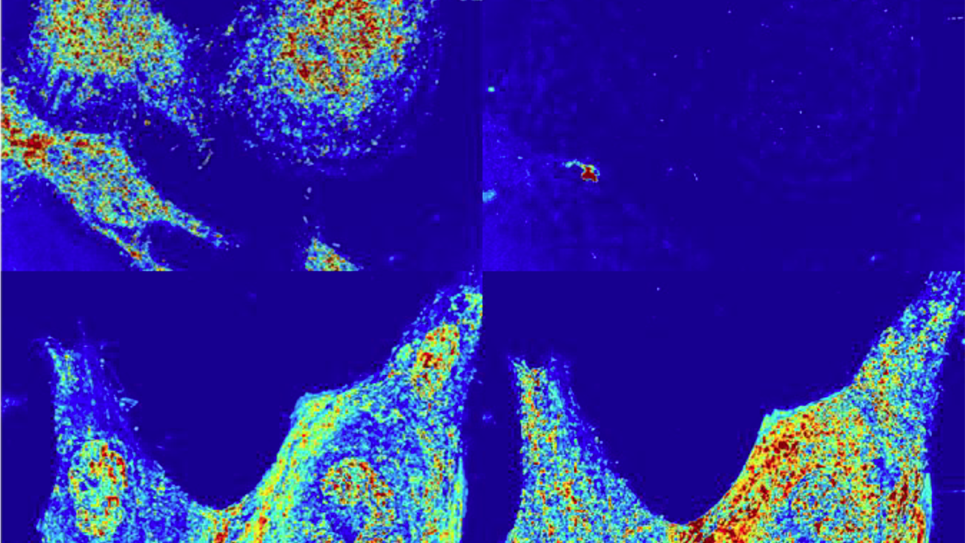
Alterations of the nanoscale structure of live HeLa cells after chemical fixation, as observed using partial wave spectroscopic optical microscopy. (Image: Vadim Backman, Northwestern University)
Shedding light on the dark universe
An Argonne-led team used Mira to carry out some of the largest and most detailed simulations ever performed on the evolution of the universe. Their work resulted in the first simulations accurate enough to compare with large-scale cosmological surveys. Their work on Mira has led to the creation of cosmological maps that help improve the analysis of data from some of world’s largest astronomical surveys, such as the Dark Energy Survey. These synthetic sky maps allow scientists to better understand the gravitational forces at work on large-scale structures in the universe and, by extension, some of cosmology’s greatest mysteries, including dark energy and dark matter.
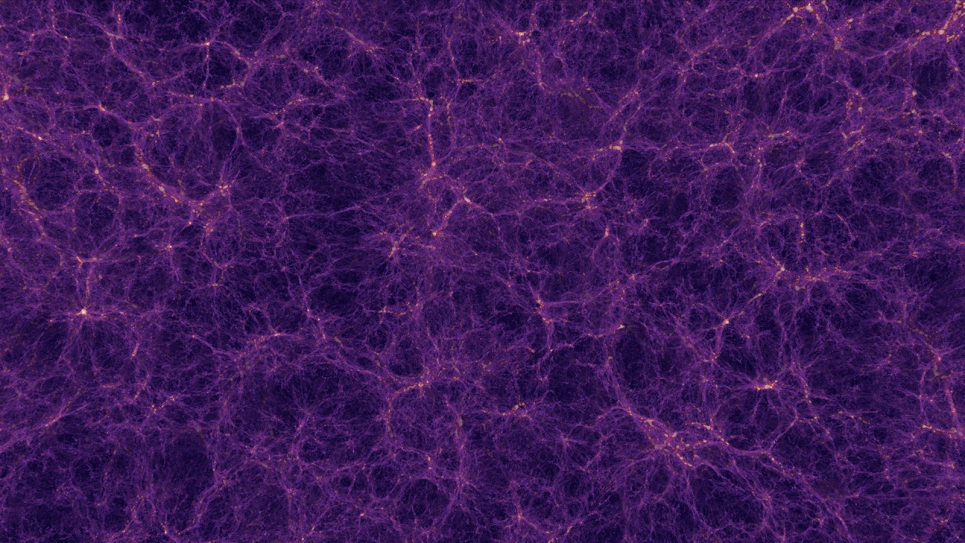
Carried out on Mira, the Outer Rim simulation evolved more than one trillion particles to model the distribution of matter in the universe. (Image: HACC team, Argonne National Laboratory)
Improving the performance and production of concrete
Concrete is the most widely used building material in the world, but the production of its ingredients, namely cement, is a significant contributor to the world’s greenhouse gas emissions. To enable the design of new, more sustainable mixtures of concrete, researchers from the National Institute of Standards and Technology (NIST) performed simulations on Mira to better understand concrete’s flow properties. The NIST team used their simulation results to create Standard Reference Materials for industrial researchers to calibrate concrete rheometers — instruments used to measure the flow of complex fluids — for materials development. Knowledge gained from the NIST simulations is critical to helping researchers expand the use of alternative materials and zero in on the optimal recipes for producing more sustainable concrete.
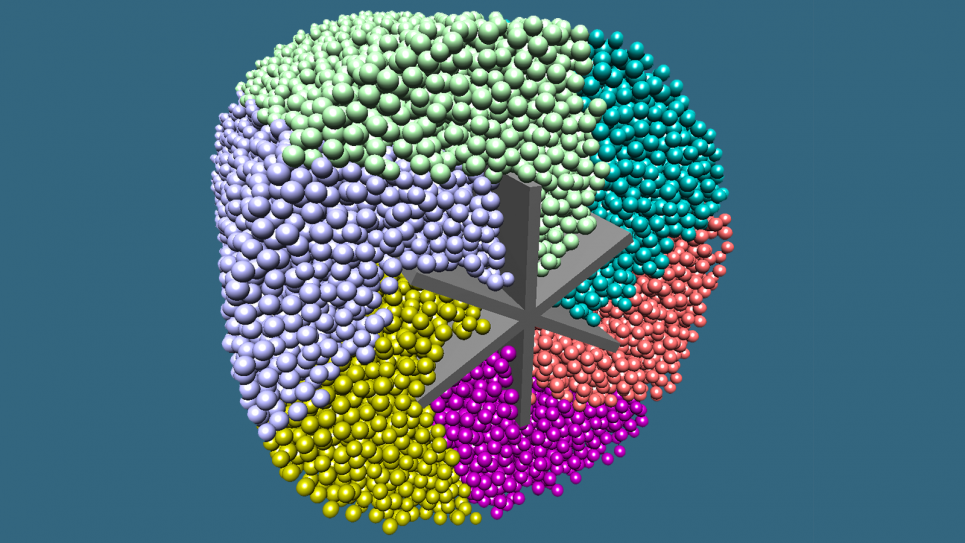
This simulation image shows suspended particles in a rheometer for a Standard Reference Material (SRM) for mortar. The spheres, which are color coded by their starting location in the rheometer, are suspended in a cement paste with properties derived from NIST's cement paste SRM. (Image: Nicos Martys and Steven G. Satterfield, National Institute of Standards and Technology)
Simulating particle collision events for the Large Hadron Collider
Particle collision experiments at CERN’s Large Hadron Collider (LHC) — the world’s largest particle accelerator — generate massive amounts of data that must be processed and analyzed to aid in the facility’s search for new physics discoveries. To help tackle this big data challenge, an Argonne-led team used Mira to simulate LHC collision events. This marked the first time a leadership-class system was used for such simulations, thus demonstrating how DOE supercomputers can play a role in meeting the LHC’s growing computing demands. Mira enabled the simulation of millions of particle collision events in parallel, while freeing the LHC Computing Grid to run other, less compute-intensive jobs. The team’s work also demonstrated how leadership computing resources can be used to inform and facilitate other data-intensive high energy physics experiments.

Scientists used Mira to simulate millions of particle collision events for the Large Hadron Collider’s ATLAS experiment. (Image: Joseph A. Insley, Argonne National Laboratory)
Accelerating the design of more efficient engines
With access to Mira, Argonne researchers have worked with the automotive industry to develop powerful engine modeling and simulation capabilities that can help optimize complex fuel spray and combustion processes for a variety of fuels over a wide range of operating conditions. In one case, Argonne worked with a global petroleum and natural gas company to pinpoint engine designs for a given fuel. They were able to reduce design time from months to weeks by using Mira to simulate more than 2,000 engine-fuel combinations. Their work resulted in two optimized fuel-engine concepts with the potential to substantially improve fuel efficiency.
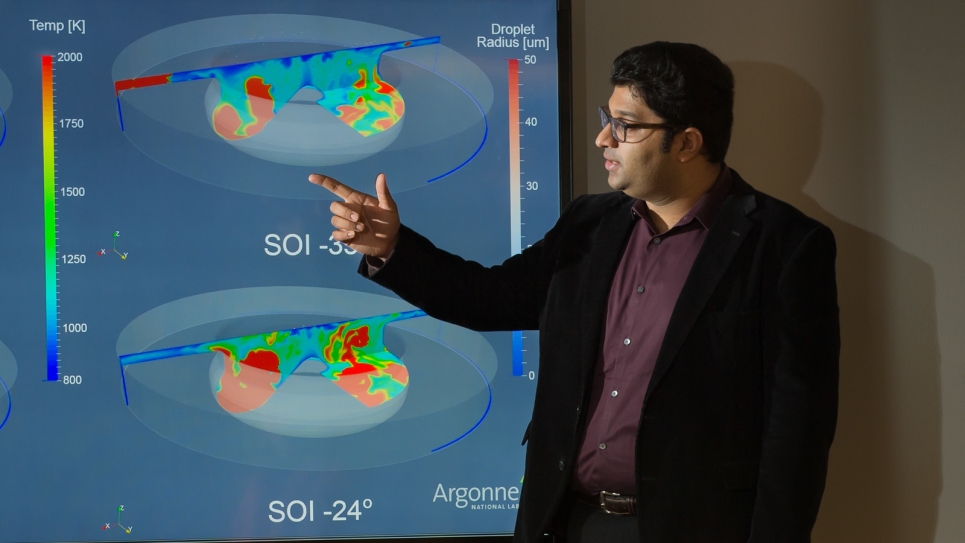
Argonne’s Sibendu Som explains how simulations on Mira helped to inform the design of advanced automotive engines. (Image: Argonne National Laboratory)
Modeling planetary and stellar magnetic field generation
Using Mira, a multi-institutional team led by the University of California, Los Angeles, developed high-resolution 3D models to study magnetic field generation on Earth, Jupiter, and the Sun at unprecedented levels of detail. To shed light on the dynamics that produce magnetic fields, the researchers performed massive simulations to model the interplay of magnetism, rotation, and turbulent convection occurring within the interiors of planets and stars. Mira allowed the team to resolve a range of spatial scales that were previously inaccessible with numerical simulations. A better understanding of the magnetic field generation process is critical to gaining new insights into the birth and evolution of the solar system.
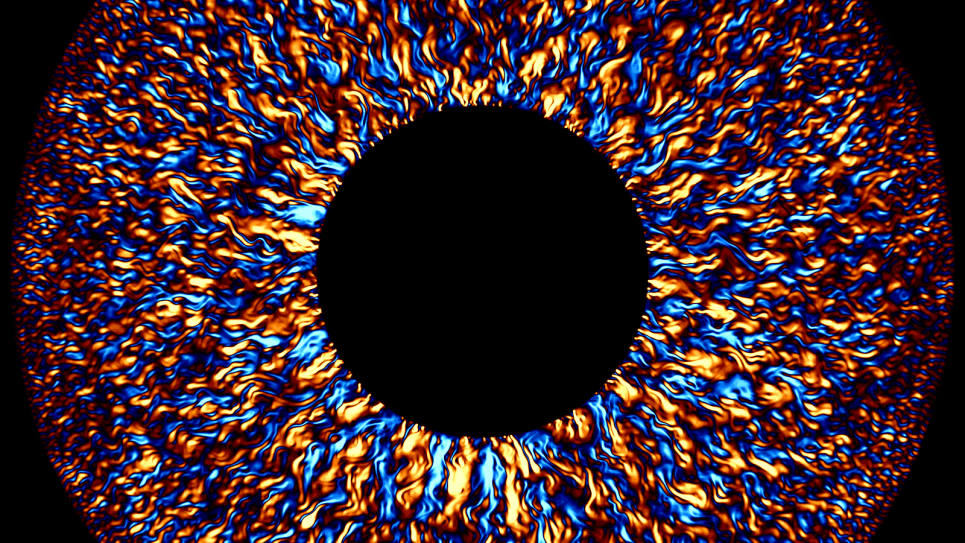
Radial velocity field (red = positive; blue = negative) on the equatorial plane of a numerical simulation of Earth’s core dynamo. These small-scale convective flows generate a strong planetary-scale magnetic field. (Image: Rakesh Yadav, Harvard University)
Advancing protein and peptide design
With the emergence of protein structure modeling tools, researchers have the ability to design proteins with targeted applications, such as treating diseases and catalyzing medically and industrially useful reactions. A research team from the University of Washington used Mira to develop and apply new computational methods aimed at improving protein structure prediction and design capabilities. Their work has included efforts to design mini-proteins called peptides for a wide range of therapeutic targets, including influenza, Ebola, HIV, and Alzheimer’s disease. After using the supercomputer to identify the most promising candidates for a given pathogen, the research team synthesized various proteins in a laboratory to experimentally validate their simulation results.
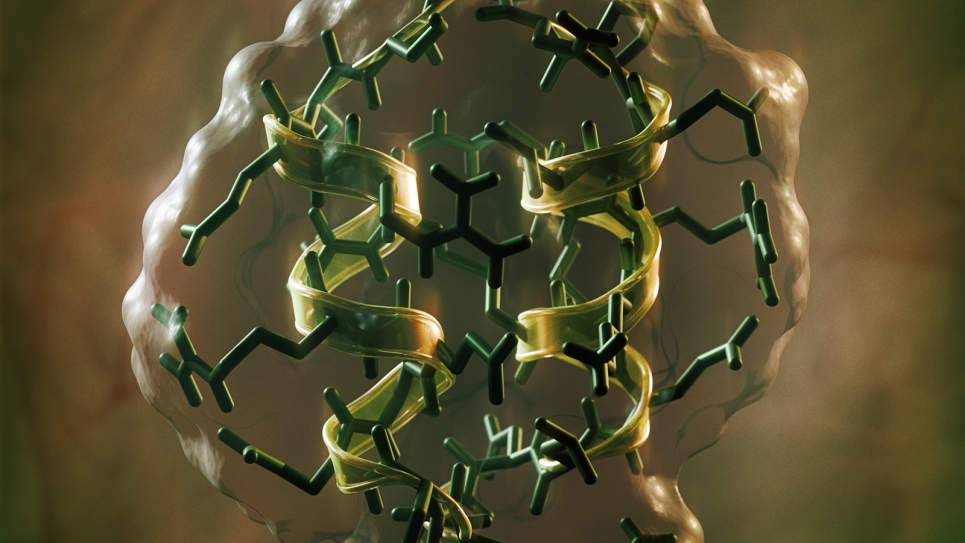
This man-made peptide contains both natural and mirror-image amino acid building blocks. The arrangement, which was modeled using Mira, gives rise to spirals that twist in opposite directions, a structure not seen in any natural proteins. (Image: Vikram Mulligan, Flatiron Institute)
Taking quantum Monte Carlo simulations to new heights
Mira played an instrumental role in making the quantum Monte Carlo (QMC) method a more effective and accessible tool for the computational materials science community. Previously limited by a lack of sufficient computing power, the computationally demanding QMC method is capable of providing accurate predictions of materials properties that elude traditional methods like density functional theory. Mira’s massively parallel architecture was particularly well suited for the QMC approach, which requires computing a huge number of samples simultaneously to calculate the complex interactions between many electrons. In one example, researchers from Argonne, Oak Ridge, Sandia, and Lawrence Livermore national laboratories used Mira to carry out QMC simulations that accurately captured the magnetic properties of the titanium oxide material, Ti4O7, for the first time.
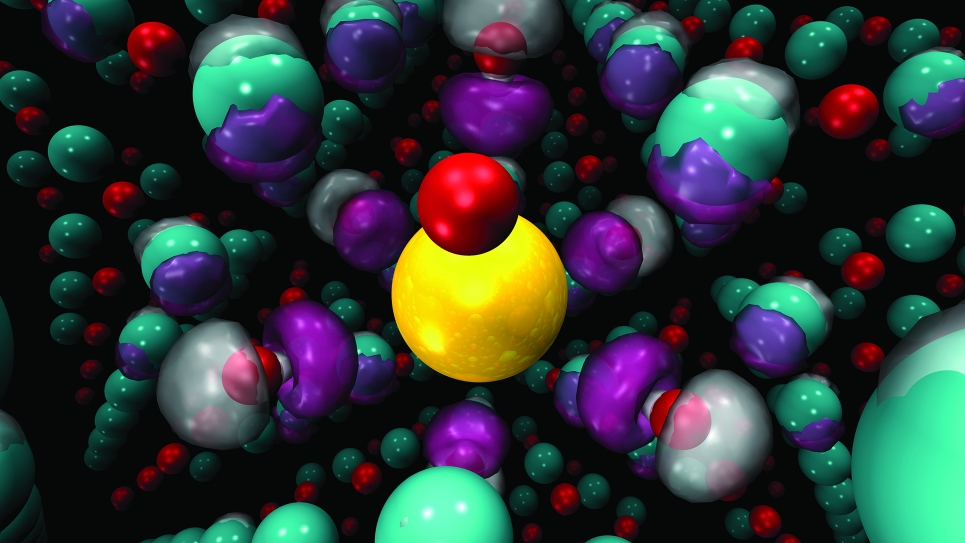
With access to Mira, researchers were able to use the computationally demanding quantum Monte Carlo method to study the properties of materials like potassium-doped nickel oxide. (Image: Joseph A. Insley, Argonne National Laboratory)
Informing the design of next-generation nuclear reactors
Fast reactors are a promising nuclear energy technology that can substantially reduce radioactive waste and efficiently utilize natural nuclear resources. To help accelerate the design of safe and economical fast reactors, an Argonne-led research team has used Mira to model and analyze new reactor designs through high-fidelity multiphysics simulations. The end goal of nuclear modeling and simulation efforts on Mira and other DOE supercomputers is to remove some of the initial obstacles that the nuclear industry faces as it considers the design, licensing, and deployment of next-generation reactors.
Argonne researchers Alexsandr Obabko and Emily Shemon discuss one of their nuclear reactor turbulent flow simulations in the data visualization lab at the ALCF. Image: Argonne National Laboratory
Driving a new era of scientific breakthroughs
Now that Mira has been retired, the ALCF’s current leadership-class system, Theta, is continuing the lab’s legacy of providing supercomputing resources that enable researchers to accelerate pivotal discoveries in science and engineering. In fact, many of the aforementioned projects are now using Theta and other DOE supercomputers to further advance their research. And as the future home to the Aurora exascale supercomputer, Argonne is positioned to drive a new era of scientific computing breakthroughs when the system arrives in 2021.
Argonne National Laboratory seeks solutions to pressing national problems in science and technology. The nation's first national laboratory, Argonne conducts leading-edge basic and applied scientific research in virtually every scientific discipline. Argonne researchers work closely with researchers from hundreds of companies, universities, and federal, state and municipal agencies to help them solve their specific problems, advance America's scientific leadership and prepare the nation for a better future. With employees from more than 60 nations, Argonne is managed by UChicago Argonne, LLC for the U.S. Department of Energy's Office of Science.
The U.S. Department of Energy's Office of Science is the single largest supporter of basic research in the physical sciences in the United States and is working to address some of the most pressing challenges of our time. For more information, visit https://energy.gov/science